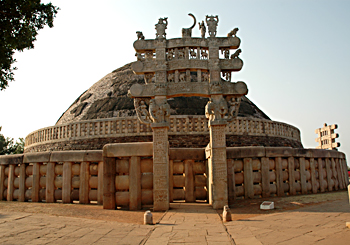 Buddhism had received enough royal patronage in the Indian subcontinent and that is an important reason as to why Buddhist architecture developed in India. The most important patronage of Buddhism was Ashoka an emperor of Maurya Empire. Backed by a sound economy and efficient administration the Mauryas consolidated their control over the whole of north India. Chandragupta`s son Bindusara extended Mauryan control well into the Deccan and his grandson Ashoka took the Indian empire to its greatest extent. In the last quarter of the 4th century BC Chandragupta Maurya had established his control over the entire northern part of India. During his time columned halls or mandapas and multi-storeyed residential houses or prasadas had become predominant. The architectural features of Chandragupta Maurya bore a Persian influence.
Buddhism had received enough royal patronage in the Indian subcontinent and that is an important reason as to why Buddhist architecture developed in India. The most important patronage of Buddhism was Ashoka an emperor of Maurya Empire. Backed by a sound economy and efficient administration the Mauryas consolidated their control over the whole of north India. Chandragupta`s son Bindusara extended Mauryan control well into the Deccan and his grandson Ashoka took the Indian empire to its greatest extent. In the last quarter of the 4th century BC Chandragupta Maurya had established his control over the entire northern part of India. During his time columned halls or mandapas and multi-storeyed residential houses or prasadas had become predominant. The architectural features of Chandragupta Maurya bore a Persian influence.
Emperor Ashoka had embraced Buddhism after he had carried on a number of conquests and expansion policies. The Emperor is known to have left his great works of architecture in the form of stone curvatures and edicts which were carved on stones. The fact that Ashoka took Buddhism as a unifying force was very evident from his architectural designs. Ashoka is credited with having disinterred the remains of Lord Buddha from their original ten stupas for redistribution and redefining them in new stupas throughout the empire. By many of the new stupas he erected pillars (stambha) inscribed sometimes with exhortation against faction in the Sangha, sometimes with messages of wider implication, supporting devices of Buddhist and imperial symbolism. The Sanchi Stupa is a living example of Ashoka`s magnificence in architecture. But unfortunately after Ashoka the Maurya Empire could not flourish much. Soon they lost grounds to others.
After Mauryas the Kushanas were important patrons of Buddhism. The commercial developments and trade contacts fostered by the earlier Mauryas prospered once more under the Kushana Empire. The Kushana Rulers were markedly tolerant towards Buddhism, especially as the rigid caste laws of Brahmanism made access to Indian society difficult. Kanishka, indeed, was Buddhism`s greatest patron after Ashoka. A notable Buddhist piece of architecture during the time of Knaishka was the Kanishka stupa. Besides stupas, Kanishka had tried to popularize the spirit of Lord Buddha through various features including coins and statues.
Finally it can be concluded saying that the emperors had popularized Buddhist forms of art and architecture in order to spread the spirit of Buddhism among the masses.




